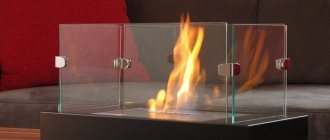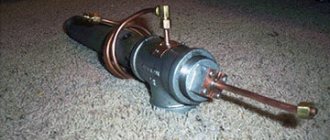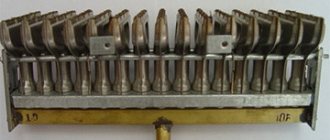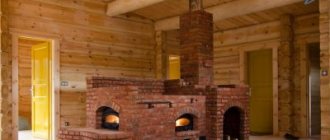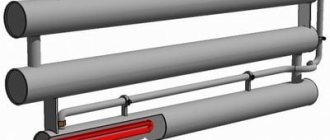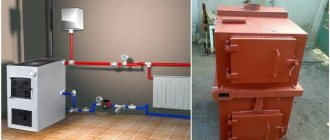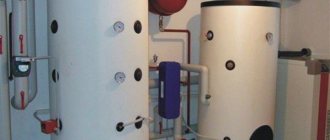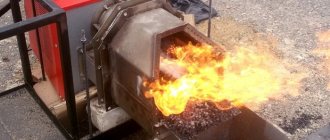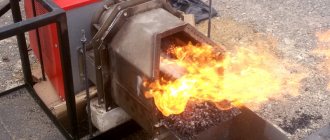The ecological type of fireplace, unlike gas and wood-burning equipment in this category, can be used in multi-storey buildings. To organize it, you do not need to obtain permission from the administration. There is no need to build a chimney or fuel storage facility. And if the hearth is decorated in an interesting way, the burner for the bio-fireplace is made with your own hands, the costs of arrangement will also be significantly reduced. Isn't it true?
You will find everything about how to make a spectacular eco-fireplace with a trouble-free fuel cell in the article we presented. Using the information provided and valuable advice, you can make your own stunning piece of furniture that will not create the slightest threat during the burning period.
Our article describes in detail the process of self-manufacturing three types of burners for installing biofireplaces. Interesting decoration options are presented, and recommendations are given for the safe use of spectacular homemade products. The presented material is supplemented with photo illustrations and video guidance.
Pros and cons of biofireplace
Biofireplace has its advantages and disadvantages. The most significant of them.
Pros:
- easy to light and extinguish;
- does not require additional devices or power supply;
- this is an additional source of heat;
- safe combustion products.
Minuses:
- often the fire in the device is in an open structure, this is not always safe;
- the purchase will cost a decent amount;
- expensive fuel that burns quickly.
A desktop biofireplace may have an original design solution
general information
The biofireplace is a simple system, the basis of which is the combustion of liquid fuel, bioethanol. Biological fuel is nothing more than natural alcohol, so when burned, only steam and a small part of carbon dioxide are released. Pure alcohol burns with a blue flame, but a yellow fire should blaze in a fireplace, so bioethanol contains various additives that add realism to the fire.
Let us note that it is important not only that a homemade bio-fireplace is easy to manufacture, but also that for its operation it does not require the installation of a chimney, an exhaust hood, or the installation of engineering systems and communications. All that is needed for the full operation of the system is regular ventilation of the room to supply fresh air saturated with oxygen.
After all, as you probably know, oxygen is actively used in the combustion process of alcohol fuel.
Modest biological fireplace
Despite the fact that the operating principle and design of a biofireplace are always the same, there are a large number of different variations in the design of this device. Most often you can find the following varieties in stores:
- Floor-standing options can be installed along the wall or designed to be placed in the corner of the room. These systems can be large or small in size, allowing the bio-fireplace to be moved anywhere in the room.
- Hanging and built-in options have more modest dimensions. Such eco-fireplaces are hung on walls or mounted in special niches prepared in advance for these purposes. An interesting point is that such devices are fixed both in walls and in furniture, for example, in cabinets, on coffee tables.
- Tabletop options are a miniature version of a floor-mounted biofireplace. These decorative devices will fit perfectly on your table, shelf or nightstand. The easiest way to make a desktop biofireplace yourself is to fully evaluate how such devices work.
Tabletop variation on the biofireplace theme
Regardless of which biofireplace design is chosen, factory models usually provide the ability to adjust the height and pressure of the flame. If you make it yourself, this can be done by working with burners.
Burner device for a biofireplace
The biofireplace consists of several elements. Each of them has certain requirements, which ensures safe operation of the device.
The main components of a biofireplace are the body, a protective metal grille and a fuel container.
Fuel container
The main element of a biofireplace is a container for fuel; it is made of metal. It doesn’t matter how it looks externally, it still won’t be noticeable. The main criterion is resistance to high temperatures and sealed joints so that fuel does not leak.
You can use a regular tin can as a container for fuel.
There should be at least 10 cm from the fuel container to the walls of the portal or housing. If the presence of several burners is implied, they are placed at some distance from each other, about 5-10 cm.
Frame
The body of the bio-fireplace must be made of heat-resistant material; it is advisable to treat it with paint that is resistant to high temperatures.
The biofireplace portal can be from:
- fireproof glass;
- metal;
- ceramics;
- marble.
Metal housing is one of the most common solutions
Fuel
The fire burns using bioethanol, an environmentally friendly liquid made from alcohol, which when burned emits only carbon dioxide and water. When using it, there is no unpleasant odor in the apartment.
Liquid fuel is obtained by processing agricultural crops, such as potatoes. Sometimes the fuel can be gel-like.
Fuel is usually available in large transparent bottles
500 ml of fuel lasts for 1.5 hours.
Important! Industrial alcohol cannot be used for bio-fireplaces. It will release sulfur vapors into the air, which are harmful to the body.
Wick
The inner and outer parts are connected by a wick. There are no special requirements for it; you can use a regular lace or a piece of fabric.
The wick for the fireplace can be ordinary twine
Metal grate
The metal grill allows you to evenly distribute heat over the entire area. It is also convenient to place decorative elements in the form of stones, shells, etc.
The metal grill can be ordered separately or made independently
Safety
Operating a biofireplace can be hazardous to health if a number of simple rules are not followed.
Precautionary measures:
- If the fireplace is large, it is better to install fireproof glass protection around it.
- The housing can be made of any heat-resistant material, usually a metal box.
- Fuel should only be added when the fireplace is in use. Alcohol-based liquid will still evaporate if left in the open air. Such regular fumes are not harmless.
- The fire should not be left unattended or placed near drafts or fans.
- When assembling the burner body, you should carefully check the tightness of the seams.
- The distance between flammable objects and the fireplace must be at least 1.5 m. Between other objects, at least 1 m.
Key Features
Before you begin assembling and making a fuel tank for a biofireplace, it is recommended that you familiarize yourself with the basic requirements and features that apply to it:
| Design features | Descriptions and characteristics |
| High quality | When doing the assembly yourself, give preference to high-strength, high-quality and fire-resistant materials. Alternatively, you can use stainless steel. A fuel block made from this material will serve you for many years and will not require modification or replacement. |
| Optimal ratio | The biofireplace fuel block must have sufficient thickness of each element and wall. Thus, when exposed to high temperatures, strong heating, as well as sudden temperature changes, the material will not collapse, deteriorate, melt or deform. |
| Appearance | The fuel block of a biofireplace with your own hands should not contain any damage, deformation, scratches or chips on its surface. Each element is securely fixed and screwed to the fuel tank using special fasteners and suitable fittings. |
Advice: since steel and any other fire-resistant materials tend to become very hot during operation, it is recommended that their inner surface be well insulated before use. This will make them safe and allow them to be installed in houses and apartments where there are small children. Since bioethanol burns, it is also recommended to enclose the flame in a tall glass frame, fenced on several sides.
Types of burners for biofireplaces
Although biofireplaces differ in external parameters, their internal structure is almost the same.
There are only 3 types of burner devices:
- capillary;
- gravity;
- wick.
The standard biofireplace burner is simple in design
Capillary
A capillary burner requires the use of a precisely measured dose of fuel. It is drawn into the burner itself using capillary forces.
It has a number of disadvantages:
- While the evaporator is warming up, there is a smell of alcohol;
- at the beginning of combustion, the flame flares up strongly, but calms down after a few minutes;
- an excess of fuel provokes splashes, which can be dangerous at high temperatures;
- there is always some unspent fuel left in the capillary device;
- It is necessary to have a damper to regulate the fire;
- the filler has to be changed because it regularly becomes clogged with combustion products.
The simple design of the capillary burner can operate for up to 2 hours
Gravity
The fuel immediately enters the evaporator. Due to this, the fireplace is ignited immediately. The fire is kept stable, there is no need for a damper, but it is added to regulate the flame for decorative purposes. The design is quite complex and cannot be repeated on your own.
Fuel in a gravity-flow device is used to the end due to heating of the fuel tank
Wick
The wick burner evaporator is also a fuel tank that is heated by a flame. Refueling is carried out “by eye”; overfilling of fuel is not dangerous. The main thing is that the filler is completely saturated with fuel.
There is no need for a damper since the flame is stable.
A wick burner must have a metal grate to distribute heat
Important! Some commercial fireplaces operate from a wall outlet. This is due to the additional function of lighting, sounds, etc. The fire is always real, there is no urgent need for electricity.
Some tricks
A bio-fireplace will become truly safe and will delight the eye with its sparkle if, firstly, its burner is equipped with a damper to adjust the flame. Why - see above. Secondly, the alcohol flame is visually sluggish: bluish, almost colorless. This, of course, is good: the blue color of the almost transparent flame indicates complete combustion of the fuel. But it wouldn’t hurt to revive the flame of the bio-fireplace by brightening it up. For this purpose, 5-10% of rectified (not cracked!) 100-octane highly purified gasoline is added to branded biofuel for fireplaces; This is also how gasoline lighters are refilled. Natural 100-octane gasoline is oh so expensive, but that’s not all. Its viscosity and surface tension are much greater than those of alcohol and it travels through capillaries more slowly. Therefore, it is the gasoline additive that poisons burner fillers the most. Manufacturers are no worse off for this - they sell more replacement burners. It’s better for us to put a damper on the burner and tint the flame ourselves.
Damper
Many branded linear burners for bio-fireplaces, incl. leading manufacturers are equipped with a damper with one handle running in the grooves under the cover, on the left in Fig. below. Clearly an irrational design: it is impossible to move the hot damper by hand, and if the damper is pulled and, especially, pushed with a stalk (see below), it easily warps and jams.
Incorrect and correct (right) designs of burner dampers for biofireplaces
The damper on 2 handles suspended in the slots of the lid (in the center in the figure) can, in principle, be quickly moved by hand. But fuel vapors leak through the slots, which can ignite in the air. The correct design of the burner cover damper for a biofireplace is sliding in the grooves under the cover with 2 handles; This one easily moves back and forth with a stalk made of a steel bar (on the right in the figure).
How to paint a flame
The most effective and safe way for both the burner and people to color the flame of a bio-fireplace is to add chromatizer metal ions to it, which emit bright lines in the visible part of the spectrum. A completely insignificant admixture of chromatizers, difficult to detect by subtle chemical analysis and in no way perceptible by humans, is enough, and the flame will sparkle. For flame colorization to be effective with chromatizers, 4 conditions must be met:
- The ionization energy of the chromatizer metal and the excitation energy of its ions must be low so that the flame temperature is sufficient for this;
- The exposure time of the excited chromatizer ion should be as short as possible so that it, excited by the flame, immediately flares up;
- The chromatizer ion must glow in the red, orange and yellow regions of the spectrum so that the flame has a natural color;
- The admixture of chromatizer ions in the air, perceptible by our senses, should be harmless to humans, both with a single exposure and with long-term regular exposure.
Of those readily available, the above conditions are met by chromium and sodium ions. Chrome gives spectacular color shifts throughout the desired part of the spectrum; sodium - in yellow. A fairly easily released chromium impurity is always present in natural quartz and quartzite. It is enough to cover the mouth of the bio-fireplace burner with quartzite pebbles, and the flame will sparkle “like a real one”, pos. 1 in Fig. There is enough chromium in granite of any color, but besides it, this stone contains many not so harmless impurities, incl. radionuclides. Therefore, there is no need to color the bio-fireplace flame with granite, pos. 2.
Methods for coloring a biofireplace flame
Note: for the same reason, stones for backfilling a homemade tabletop bio-fireplace must be taken carefully. You should look for white or translucent solids with a glassy fracture, but red and yellow ones should be avoided at all costs. These probably contain very harmful cadmium and sulfur.
With tabletop and, especially, with mini-biofireplaces, the matter is more complicated. Their low-power burners either will not heat the stones enough for the chromium to be released into the flame, and it will remain “dead” alcohol (item 5), or, if a more powerful burner is installed, the fuel will boil and the fireplace will become dangerous. Branded bio-fireplace candles are either filled with a specially prepared filler containing water-soluble chromium compounds, pos. 3 (biofuel always contains water), or are equipped with a mesh divider made of chromium-nickel steel, pos. 4. The last option is not optimal: nickel in the air is of no use, chrome from the mesh quickly burns out, and the mesh itself burns out.
If the bio-fireplace burner is linear, then the alcohol flame with dancing tongues from it is quite impressive, pos. 5. You can color it even more by throwing literally a few grains of ordinary table salt into the fuel tank or block, pos. 7. Sodium is a very active chromatizer. Dip the tip of a knife into kitchen salt, shake it off and put it into the flame of a gas stove; it will immediately turn yellow.
Types of biofireplaces
Before you start designing a biofireplace, you should figure out where it will be located and what function it will perform.
Biofireplaces are:
- desktop; Compact devices do not take up much space
- wall; A wall-mounted fireplace will fit harmoniously into the living room
- floor Floor-standing device ideal for large rooms
Tabletop fireplaces are usually small in size, round or rectangular in shape, made of ceramic or metal. The distance from the glass to the burner should not be less than 10 cm.
Wall-mounted fireplaces always have an elongated rectangular shape so that they can be easily attached to the wall. The back wall is always made of heat-resistant material, such as metal. The front part is made of fireproof glass.
Floor biofireplaces are the largest. They are often made decoratively like standard fireplaces with a chimney. If this is an ordinary bio-fireplace, it is simply installed on the podium.
Are there other biofuels?
Biofuel is so named because it burns freely in air without leaving any residue, consuming little oxygen. And ethanol is not the only one in this regard. Alternative biofuels are paraffin and stearin. Yes, yes, from which they make lighting candles. There is no need to tint their flame, it is already alive. The only drawback is the small narrow tongue. But it can be turned into a bush, quite suitable for a mini bio-fireplace-night light or tabletop, by passing it through a flame divider, at least also made of stones. How to make a bio-fireplace night light from a candle, see the video tutorial at the end:
How to make a burner for a biofireplace with your own hands
A burner for a bio-fireplace, the drawing of which must be drawn taking into account all dimensions, is assembled from a tin can, a body and a wick. Next, if desired, install a metal grate, mineral wool, fireproof glass, etc.
Drawings of the body of biofireplaces of wick, capillary and gravity type will help you assemble the devices yourself
Important! You cannot make fuel yourself; combining combustible elements can lead to unpredictable reactions.
Simple burner
The simplest option is a tin can burner. Bioethanol is poured into the container. For better heat distribution, you can put a metal grate and put stones on it for beauty. The area above the hole is set on fire.
It would be good if the fireplace body was metal with double walls.
The simplest burners resemble a tin can
Burner with filler
The operating method is similar to a simple burner, but mineral wool or glass wool is used as a filler. The best option is white glass wool on an acrylic base; it absorbs liquid well and easily allows vapor to pass through.
When filling the container, the cotton wool should not be compacted; it should be placed freely in the container. A metal mesh is installed on top, then fuel is poured. Cotton wool quickly absorbs bioethanol and prolongs its burning time.
Burners for a biofireplace with mineral wool are one of the options for a more complex design
Decorating a burner for a biofireplace
Decorations neatly hide the burner elements and help turn an ordinary fireplace into a stylish piece of furniture.
Decoration materials:
- any natural stones, pebbles;
- ceramic dummies of logs;
- shells;
- dummies of glass ceramic coals.
Decorative elements depend on the interior in which the fireplace will be located.
For rooms with a light interior, a combination of shells and white round stones is suitable.
A fireplace decorated with white stones is suitable for a living room in Art Nouveau style
For a classic living room, it is better to choose imitation logs or coals. Most often, the fireplace is decorated with various natural stones.
Imitation of a fireplace with a chimney
The imitation of a real fireplace with a portal is very popular. This burner design for a bio-fireplace will not differ from a conventional tin can design.
The portal is made of plasterboard and metal profiles. Painting is carried out with acrylic dye with mineral pigment. The vault must be treated with heat-resistant enamel, this will protect it from fire.
Such portals still have a risk of ignition; when using a biofireplace, you should not move away from the structure.
